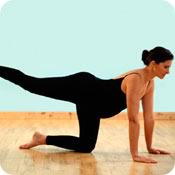
You've heard that it is acceptable, even encouraged now, for pregnant women to maintain an exercise program. This is especially true if you had a fitness routine prior to conception; it is appropriate to continue this with just a few modifications. Things become trickier, however, if this was not the case. The best idea, if you plan on becoming pregnant is to start an exercise program before conceiving. If you do begin a program after becoming pregnant, check with your doctor, start off with short intervals of exercise at a fairly low intensity, and increase only to moderate intensity gradually over time. You want to strengthen your own body, without risking injury to yourself or strain to the baby. The purpose should never be to lose weight while you are pregnant, but rather to simply feel better, sleep better, and prepare your body for the months to come. As always, it is a good idea to consult a doctor before starting an exercise program.
It is important to warm up and stretch
Beginning an exercise program can be very overwhelming and painful if you aren't careful. Warming your body up and stretching prior to exercise is very important for your health, as well as that of your baby. Especially while pregnant, take things slowly. If at any time you feel dizzy, experience cramps, or have any vaginal bleeding, simply stop. Warming up and stretching before exercise is important, however, since it serves to raise your body and muscle temperature, along with preparing your cardiovascular system, respiratory system and nervous system for the demands of exercise by increasing the blood circulation slowly. ACOG contraindications to exercise women with significant heart disease, restrictive lung disease, preclampsia, hypertension, history of placental problems in current pregnancy, or those with placenta previa at 26 weeks or third trimester bleeding.
Warming up will allow all of your connective tissues, muscles, and joints that haven't been stretched in a while to handle the stress put on during exercise, limiting your chances for injury. Connective tissue is similar to hard plastic; if you don't warm-up plastic it won't be flexible, and is much more likely to "break."
Proper warm-up and stretching also helps reduce the severity of soreness the next day or two following exercise. The increased blood flow helps deliver more oxygen to the muscles and helps get rid of the waste products that contribute to soreness. Increased blood flow also helps bring more fuel to your body, resulting in better performance.
Continued ›
| 

.jpg)




Member Comments